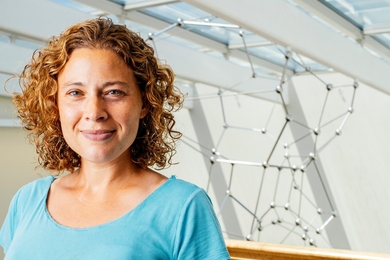At first glance, yeast cells growing on a Jello-like medium look breathtakingly beautiful -- like gossamer flowers with radial spokes emanating from a central hub. But a florid fungus like this can be a dangerous beauty, able to coat medical implants with thin films causing serious complications in patients with hip and valve replacements. In fact, thousands of deaths can be traced every year to fungal infections around medical implants.
Now, researchers at the Whitehead Institute for Biomedical Research have found a key gene that allows fungi to stick to plastic surfaces and form thin coatings called biofilms. The gene, called FLO11, is required for fungal biofilm formation. The results, published in the February 2 issue of Science, come from Professor Gerald Fink and Dr. Todd Reynolds, and lay the groundwork for finding ways to prevent biofilm formation.
"Fungi represent a real medical threat because they can stick to plastic. A fungal infection can lead to complications for contact lens wearers and, more seriously, patients with hip replacements. Often, the only way to treat the problem is to remove the implant," said Professor Fink, director of the Whitehead Institute. "Our work represents a key step toward understanding how fungi stick to plastic and offers hope that it may be possible to prevent such infections in the future."
In this study, the researchers found that baker's yeast (Saccharomyces cerevisiae) adhered to plastic plates, suggesting that like their infectious fungal cousins, yeast, too, can form biofilms.
This came as welcome news to geneticists who have long used yeast as a model for infectious fungi such as Candida. Yeast offer scientists many experimental advantages: a completely sequenced genome and a sexual reproduction cycle that allows genetic experiments. Also, many disease-causing organisms that form biofilms are difficult to work with in the laboratory.
Knowing that bacteria use proteins on their surface to form biofilms, Dr. Reynolds, a postdoctoral fellow in the Fink lab and first author on the paper, set out to look for a yeast protein that allows them to stick to surfaces. When he made the yeast grow in a Jello-like medium, the yeast began to spread out forming beautiful floral patterns.
Dr. Reynolds pinpointed FLO11 as a necessary gene for this ability. He then found that the same gene also allowed yeast to stick to hard plastic surfaces. When the reserchers disrupted FLO11, yeast no longer formed wide spreading floral patterns and couldn't stick tohard plastic surfaces.
Scientists were excited about this finding because they knew that FLO11 belongs to a large family of genes present in many pathogenic fungi. "The system that initiates the formation of a biofilm in baker's yeast potentially can hold true for pathogenic Candida as well. Once molecules involved in this process are identified, then we can search for similar molecules in Candida with the ultimate goal of finding new drug targets to prevent pathogenic biofilm formation in patients," Dr. Reynolds said.
The researchers are now using DNA arrays -- DNA chips that can analyze the activity of thousands of genes simultaneously -- to understand how FLO11 works in conjunction with other genes to bring about this effect.
A version of this article appeared in MIT Tech Talk on February 7, 2001.






